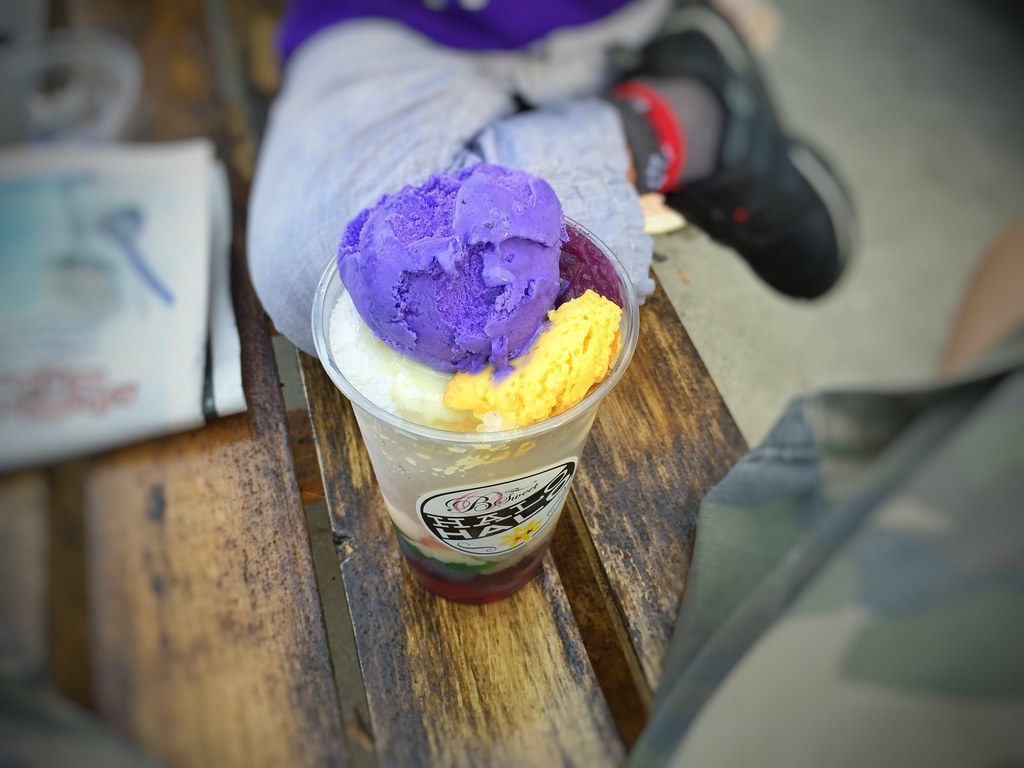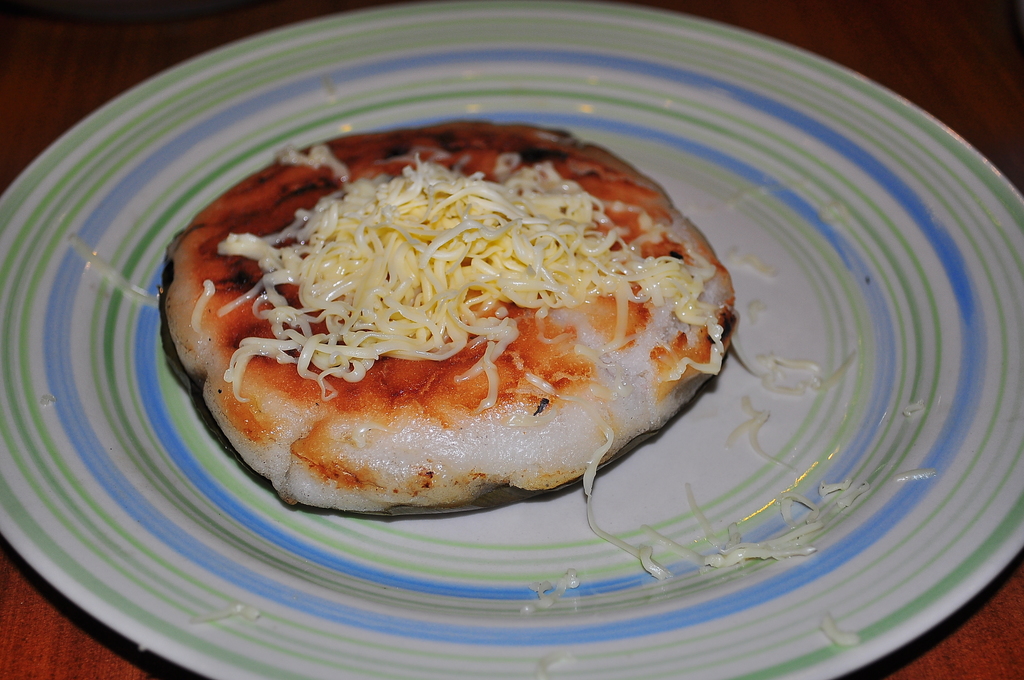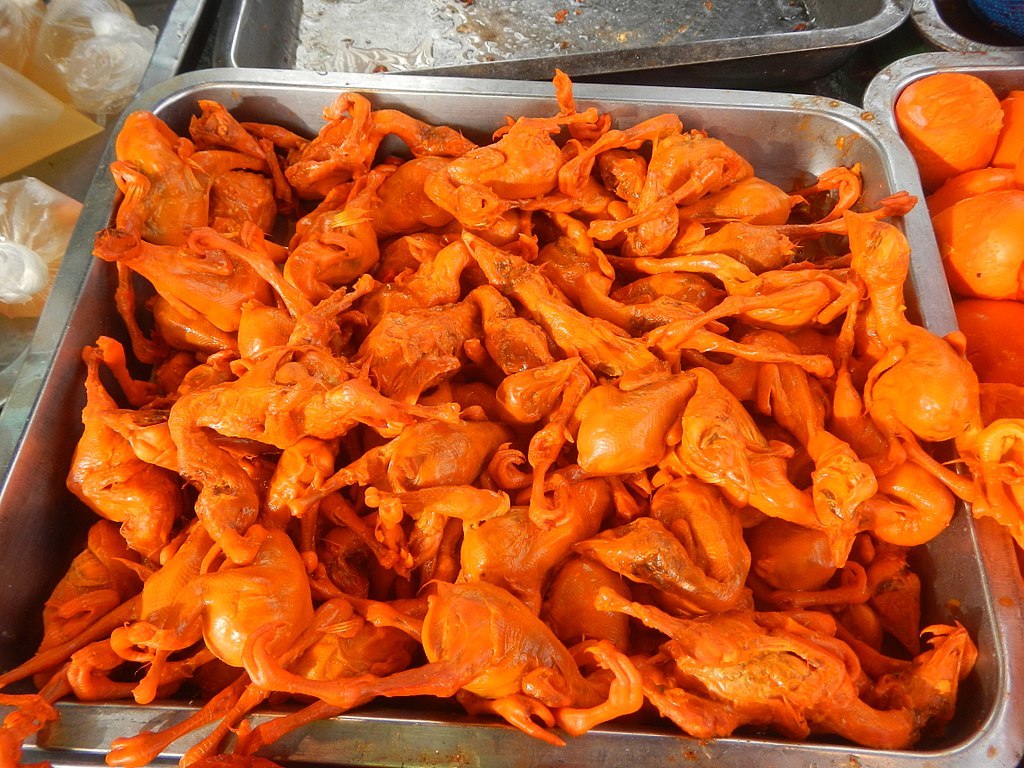Also called the Pearl of the Orient, the Philippines is a breathtaking archipelago in Southeast Asia. Captivating tourists from around the world with its diverse landscape, breathtaking beaches, and the iconic Tubattaha Reef—which is one of the Seven Wonders of the World at present—the Philippines has a natural beauty beyond compare. Also, colonized by three countries in the past—namely, Spain, Japan, and America—the nation boasts various fascinating cultural heritages. Its Western influences are evident in the modern cities and upscale districts. If its food you’re after, the Philippines will treat you to an adventure of assorted culinary delights that will blow your mind. Not to mention the street food in the country is another reason tourists are drawn to it. For your guidance, here is a list of the top street food you must try in the Philippines. Feel free to browse below.
1. Lechon

A delicious pork dish, lechon is a favorite food of a lot of Filipinos. One of the biggest influences of the Spanish on the country’s culinary aspect, it is a whole pig that is roasted over scorching charcoal. In Spanish, the word lechon translates to “suckling pig.” Although this local food can be bought in casual eateries everywhere in the Philippines, it is specially served during grand celebrations, such as birthdays, weddings, anniversaries, and others. If you want a taste of the most delicious lechon in the country, fly to Cebu as the city is popular for its sumptuous versions—some with a little spicy flavor to them. Plus, Cebuanos celebrate an annual Lechon Festival, where streets are lined with lengthy boodle fights.
2. Balut

If you fancy exotic food, you should try eating a balut when you visit the Philippines. For people who are unfamiliar with this Filipino delicacy, a balut is basically a bird embryo that is still in its shell—boiled. It is consumed by cracking the shell and eating straight from it. You can enjoy it as it is, with a pinch of salt, or you can add some drops of vinegar with chili mixture for added flavor. Balut is available on every street in every city in the Philippines because of its popularity. Also, eating one has become a comical challenge for both locals and tourists. Some upscale Filipino restaurants have included balut on their menu and have found a way to serve this local delicacy gourmet-ish style.
3. Dirty ice cream sandwich

A classic dessert that goes well with the Philippines’ warm climate, dirty ice cream sandwich is just an ice cream that is sandwiched between two pieces of bread or pandesal. In Tagalog, dirty ice cream is called sorbetes. This dessert is called dirty ice cream to distinguish from the commercialized ice creams that are sold by big companies. Compared to regular ice creams, dirty ice cream is homemade by street vendors who sell them. Most bustling plazas and public parks in the country have sorbeteros—dirty-ice-cream vendors.
You might be interested in these Airbnbs!
4. Longanisa

Another delicious delicacy that is influenced by the Spanish colonial era in the Philippines is longanisa. This local fare is somehow the same as the Portuguese linguiça. Although not really a food that you can buy on the streets, it is available in turo-turos (cheap eateries) that are proximate to schools, hospitals, and other crowded places. Longaniza is made from ground pork, and it has different tastes depending on the city where it is bought. Some varieties taste sweet, while others are garlicky. A lot of people like dipping it in vinegar to complement the sweet flavor. If you want to taste the authentic flavor of longanisa, Cabanatuan is the place to go to as the city is popular for its annual Longanisa Festival.
5. Tapsilog

A nickname that is short for “tapa, sinangag, and itlog,” tapsilog is a complete meal that is a classic favorite among Filipinos. Its three main components are tapa (marinated and dried cooked horse beef), sinangag (seasoned fried rice), and itlog (basically means egg). Usually a breakfast food, tapsilog is available in most eateries in the city at any time of the day. Even upscale restaurants have this Filipino dish on their menus. Most eateries that serve tapsilog also offer tocilog (tocino, sinangag, and itlog, longsilog (longanisa, sinangag, and itlog), bangsilog (bangus, sinangag, and itlog), hotsilog (hotdog, sinangag, and itlog), and others.
6. Puto

While in the Philippines, you can not conclude your Philippine adventure without getting a taste of a sweet puto. A local Filipino delicacy, it is steamed rice cake in bite sizes. It is practically sold everywhere in the country—streets, casual eateries, canteens, and even in upscale restaurants. Most of the time, a puto is made from rice, while others make their versions from flour. Some are plain, while other variants are topped with cheese or butter. Creatively, some Chinese restauranteurs developed a puto delicacy that is topped with sweetened ground beef (asado) and called it putopao—a combination of puto and siopao.
Traveler's tips


Derived from the Pangasinan word “tupig” meaning “to wrap,” this mouthwatering treat is more than just a delicious snack; it embodies the spirit of community and celebration. Often prepared during special occasions and festivals, the making of tupig is a time-honored tradition that has been passed down through generations. Families and friends come together, forming a joyful assembly line, as they carefully prepare and cook the delicacy, creating an atmosphere of camaraderie and shared culinary heritage.
Whether enjoyed as a delightful snack on-the-go or savored as a centerpiece during festive gatherings, tupig in Pangasinan is an edible embodiment of tradition, flavor, and the warm spirit of the Filipino people.
7. Tocino

Another local fare that is brought by the Spanish era is tocino. In Spanish, “tocino” means bacon. Compared to most commercialized types of bacon, which are salty, tocino has a sweet flavor to it. Made from the belly portion of a pig, this local food is served in cutlets or slices. It is often eaten with rice because of the intense, sweet flavor. Note that the meat’s taste differs from the mixture where it is marinated in. Also, some people like their tocino with a barbecue-ish flavor.
8. Ube

Ube is actually purple yam. A popular Filipino dessert that is made from it is halayang ube, which is simply called ube nowadays. To make halayang ube, you have to boil the purple yam and mash it afterward. It is usually served in a tray, while local retailers sell it in small jars. Its sweet taste is popular among Filipinos, and it is served in almost all local households on special occasions. If you’ve tried halo-halo, you’ll notice that ube is one of its multitude of ingredients. Some bakeshops in the Philippines make cakes with ube as the main ingredient as well.
9. Adobo

A delicious viand that is eaten with rice, adobo is an authentic Filipino food that is prepared in different ways, depending on who is cooking. Primarily, adobo’s main ingredient is pork meat, but others cook it with beef and even chicken parts. Some serve adobo dry, while others have it sauteed—the sauce adding flavor to the rice that it is paired with. Mostly, this Filipino dish has a salty and somewhat spicy and sweet taste because of its marinade and the sprinkles of black peppercorn and bay leaves. Rather than soy sauce, you may also have your adobo cooked in vinegar.
10. Empanada

Usually eaten during the afternoon, an empanada is a mouthwatering classic Filipino snack that can be consumed on its own. For people who have no idea what an empanada is, it is a bite-sized baked turnover with a flaky texture and tasty fillings, made from ground meat, green peas, carrots, small potato cubes, egg, and others. Its meat can be chicken, beef, or pork—depending on a person’s preference. Originally a Spanish food, its name actually means “enbreaded,” which very much explains its wrapped appearance.
11. Turon

If you have a soft spot for the banana fruit or any dish with banana extracts or bits of it, you will surely love turon. Turon is like lumpia—a staple Chinese food. Only that instead of ground beef, slices of banana are wrapped in a spring roll. Afterward, it is then deep-fried in cooking oil with sugar until it turns golden. This popular Filipino snack is cheap and can be found everywhere on the streets of the Philippines. Upscale restaurants’ versions of turon are much more elaborate. Some put slices of jackfruit together with the banana. Also, mango fillings, coconut flavorings, and cheese are sometimes used in making turon as well.
12. Pancit

Introduced by the Chinese people who migrated to the Philippines in the early years, pancit is a flavourful noodle dish with many toppings. Its taste is commonly salty due to soy sauce and salt—which are the main seasonings. Compared to other Asian noodle dishes like laksa and ramen, pancit doesn’t have broth. Instead, it has a fair share of sauce. Also, lots of vegetables are added to pancit, including cabbages, carrots, beans, and others, together with chicken and pork meat. In the Philippines, there are a plethora of types of pancit, such as pancit molo, pancit bato, pancit Canton, and pancit palabok.
13. Arroz caldo

Thinking of delicious food to eat during the rainy season in the Philippines? Why don’t you have some savory arroz caldo to feel a little warmer during the cold weather? Some Filipinos call it aroskaldo—a Tagalized name of this Spanish dish. For people who have no idea what an arroz caldo is, it is actually soup with mostly sticky rice and chicken parts. It creates a consistent broth that is oozing with flavor from the ginger and toasted garlic that were added during its cooking. For the final touch, Filipinos squeeze calamansi on it for an extra sour taste. Also, you can add a hard-boiled egg into your arroz caldo to make it even more special.
14. Banana cue

A Filipino snack that is usually sold together with turon, a banana cue is a traditional Filipino food that resembles a barbecue. Only that pieces of banana are skewered instead of marinated meat chunks. And unlike a barbecue, a banana cue is deep-fried in boiling cooking oil with lots of sugar, making a caramelized solution. Just like turon, it can be bought everywhere, and fancy Filipino restaurants have their versions as well. Also, other than turon, camote cue is commonly sold together with banana cue.
15. Palabok

A palabok is actually a type of pancit, but unlike regular pancit, its noodles are somehow thicker and whiter. The palabok that you can buy on the streets is the cheap version, with fewer toppings. Also, contrary to pancit, it features a thicker sauce that is not made from soy sauce but shrimp sauce. Normally, a traditional palabok has fewer vegetables and more seafood toppings, crushed chicharon, tofu, and others. A permanent dish during birthday parties, this Chinese noodle specialty is loved both by kids and kids at heart.
16. Mami

Another tasty meal that is ideal during cold weather, mami is a flavorful noodle dish that is available in turo-turos (which are laidback eateries) and cheap street-food vendors in the Philippines. A brothy noodle dish, mami uses noodles that are typically made from wheat flour. Usually, it has beef meat, asparagus, and onion chives. Chinese restaurants serve their versions with wonton dumplings, aside from meat chunks. Another type of Filipino mami is chicken mami, which contains chicken breast together with a hard-boiled egg.
17. Champorado

Champorado is another cold-weather, pick-me-up food. Just like arroz caldo, it utilizes glutinous rice. However, it is dark and does not have chicken meat or slices of hard-boiled egg in it. The flavoring comes from the cocoa powder that is boiled with the rice. And that’s just about all the ingredients that it needs, plus sugar. You can also add milk to your champorado if you wish to. Technically, it is more like chocolate rice porridge, eaten during snack time—or what the Filipinos call merienda.
18. Halo-halo

Whenever foreigners are asked what their favorite Filipino food is, halo-halo is the most named delicacy. It is a cold Filipino dessert that is bursting with flavors because of the multitude of ingredients added to it. Basically, halo-halo is made of shaved ice and evaporated milk with lots of fruits. Halo-halo is a Tagalog word for “mixed together,” which very much sums up the preparation of this fantastic dessert. Common toppings include slices of banana, mangoes, sweetened beans, halayang ube, jellies, jackfruit, and others. Restaurants’ versions of halo-halo have scoops of ice cream and leche flan.
19. Grilled tilapia

Due to the Philippines’ topography, it’s no wonder the Filipinos are big on seafood. One popular fish that is cooked in so many ways in the country is tilapia (cichlid fish). Some like it fried or sauteed, but its most preferred cooking style is grilled. Grilled tilapia, just like most of the dishes in this article, is easily accessible at various street eateries and casual restaurants. It is also a popular fare during outings and campings, as this is easy to cook. You just have to grill tilapia raw after cleaning the fish and sprinkling some salt on it. A more elaborate version of grilled tilapia has red wine vinegar, olive oil, grape tomatoes, and red onions.
20. Leche flan

Leche flan is the Filipino version of creme caramel. It is made with egg yolks mixed with condensed milk and evaporated milk. Vanilla essence and sugar are also included for added flavor. After the mixture is steamed and cooled, makers of leche flan often refrigerate it overnight in an oval-shaped llanera to develop its smooth yet jiggly, melt-in-your-mouth form. The icing on top are the layers of cream caramel sauce poured on it.
21. Sisig

A common Filipino dish that is usually an appetizer to alcoholic beverages, sisig is another tasty fare that you should not miss while in the Philippines. Almost every restaurant in the country offers it, including the small ones and cheap eateries. Sisig is generally made from scrap parts of a pig’s head, then mixed together with chicken liver. These two main ingredients are seasoned with onions, chili peppers, garlic, mayonnaise, and chili—with a dash of calamansi for the finishing touch. Basically, it’s like a sour pork salad.
22. Fishball

A favorite snack among Filipinos, fishballs are circular patties that are technically made from cuttlefish. Hence, the name. Fishballs are really cheap, and vendors of this delicacy can be found anywhere in the Philippines, except in upscale places. These treats are usually skewered like a barbecue. For a dollar, you can have as many as 50 fishballs. That’s how cheap it is. A stick of fishball is deep-fried until it turns from white to brownish in color. Once it’s cooked, you can dip it into a spicy or sweet pastelike sauce.
23. Taho

Originally a snack from the Malay heritage of the Philippines, taho is a sweet dessert that is usually sold in the morning, just in time for breakfast. Its vendors are called taho peddlers as they usually roam certain areas and shout, “Taho!” to signal that they are passing through your street. Taho is made from silken tofu, flavored with caramelized sugar and some pearls, mixed all together—and you now have one sweet treat that will surely melt your heart.
24. Bibingka

Popular during the Christmas season, bibingka is a warm cake that is usually baked from glutinous rice and coconut milk—made with traditional Filipino baking techniques using clay pots. Just like puto, a bibingka is topped with a small slice of cheese. If cheese is not your thing, you can opt for margarine too. This local delicacy is available from street vendors proximate to churches during dawn masses, a delightful breakfast food after an hour of listening to the holy sermon.
25. Lumpiang Shanghai

Whenever Filipinos are surveyed about the most popular food in the country, lumpiang Shanghai is usually the most voted answer. This Chinese food is made with egg crepe wrapped ground beef mixed with herbs and spices, then deep-fried until it turns golden brown. It is simple and easy to cook. Dip it in tomato ketchup for a complete dining experience. Some people eat lumpia like a snack, while others enjoy it with rice. What makes this food a Filipino favorite is its presence during birthday parties, anniversaries, and other special celebrations. Plus, it is available on the streets, together with barbecue, hotdogs, kwek-kwek, and the like.
26. day-old fried chicken

Up for the challenge of eating exotic foods? If so, you might have the guts to try the one-day-old fried chicken in the Philippines. Considered one of the most unique street food in the country, it is technically a newly born chick that is skewered and fried. This fare is marinated with flour and flavorings. Most street-food vendors sell it fried, while others experiment by barbecuing it. Customers have the option to dip it in spicy vinegar or a sweet pastelike sauce.
27. Puto bumbong

Usually sold together with bibingka, puto bumbong is a type of puto minus the cheese and margarine. Just like puto, it is made from glutinous rice and coconut milk. It usually features an elongated shape as it is typically cooked in bamboo tubes. Featuring a bright violet color, this snack is popular during the Advent season. After you attend dawn masses, you’ll find lots of street vendors selling it.
28. Okoy

Shrimp fritter in English, okoy is a deep-fried dish with a crunchy texture. For people who don’t know what it’s like, okoy is primarily made of unshelled miniature shrimps, glutinous rice batter, and a mixture of herbs and spices, including squash bits, mung beans, onions, carrots, and more. It can be eaten alone or paired with rice. Plus, for a complete experience, dip it in a vinegar-garlic sauce.
29. Pandesal

If there’s one popular type of bread in the Philippines, it might be pandesal. Available in almost all of the bakeries in the country, this tasty bread roll is made from eggs, yeast, flour, salt, and sugar, then baked in an oven. It is usually sold during breakfast, and Filipinos have a tradition of dipping it into their coffee before having a bite. Fun fact, pandesal means “salt bread” in Spanish.
30. Kwek-kwek

Sold commonly on the streets together with a variety of barbecue fares, lumpiang Shanghai, 1-day-old chicken, and others, kwek-kwek is a not-so-exotic egg delicacy compared to balut. It is basically a hard-boiled egg covered in marinated orange batter and fried. Also called tokneneng, a kwek-kwek is dipped in vinegar sauce or a sweet-savory paste for added flavor.
Go on a palatable culinary adventure with Pinoy street food

The Philippines is a stunning southeast Asian country that will captivate you with its breathtaking natural wonders. This archipelago features a perfect balance of nature and modern 21st-century attractions, an ideal hideaway destination for all types of tourists—adventure seekers, nature lovers, history buffs, you name it. There are lots to love about the Philippines, most especially its delicious cuisines that are rooted in its colonial era. For foodies who plan to explore this country, use this list as your guide in planning an exciting food-crawl itinerary.
History
Get Trip101 in your inbox
Unsubscribe in one click. See our Privacy Policy for more information on how we use your data




























Create an account to